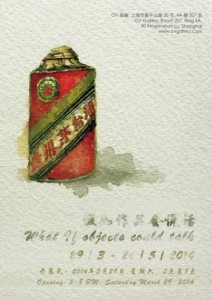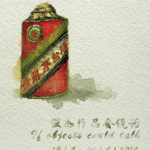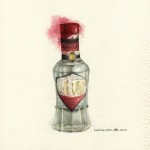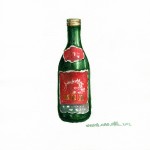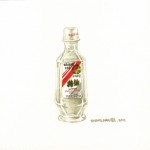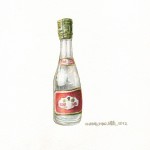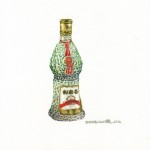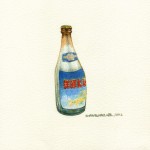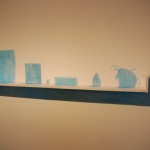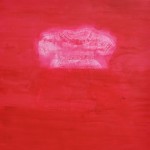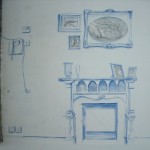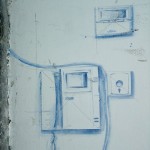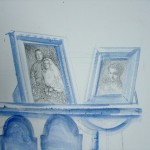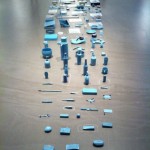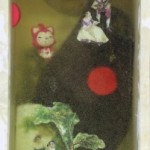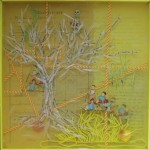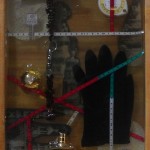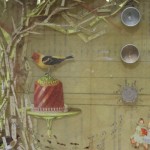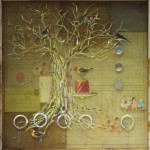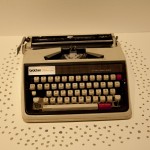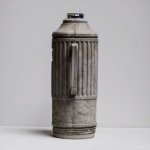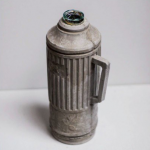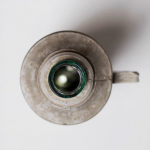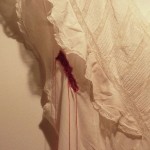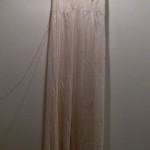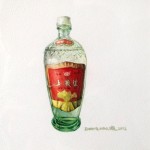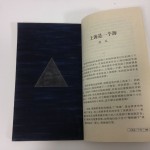Monika Lin: Monika Lin, "Memory Boxes," found objects, resin, found box, 37 x 11.5 x 10cm, 2014
The manner in which we have defined history, textbook history, is through the recording of observation and memory. Even if intended as an absolute truth, each recorded moment is based on an individual’s viewpoint, which is determined by class, race, gender; on normative behaviors, customs or interpretations; and on the memory of what that individual believes or wants to be true. Therefore, written history is always a distortion, a singular and often narrow view perpetuated by an elite group. In looking at histories, I have become interested in this selective nature of history and memory and its further transformation as it moves from generation to generation, culture to culture.
In 1995, inspired by having inherited some of my Grandmother’s, Great Grandmother’s and Great, Great Grandmother’s collections of postcards, wedding invitations, bank statements, birth and death announcements and letters, I set about to create a group of works using the inherited items and other items found or given to me.
These “Memory Boxes” are comprised of items from my family’s past, stories and objects and histories which have and continue to shape me. And, yet, they are only a portion of that history. The past and the items I inherited were selected for me from a much larger truth, just as I select which of these edited items I will use in my memory boxes. The boxes are a possibility of one history, and, in this manner, also a commentary on history en masse. Decisions regarding value/merit, representation, perspective are made through a selective, subjective process, then must survive translation to paper, generations, political (and personal) agendas before being presented. This process is specific and personal. In truth, history is as fragmented and random as my memory boxes. These boxes are a sort of examination of histories and their constructs—what we keep or edit, reveal or save privately, and how that information is shared.
Tao Damin: Tao Damin, "Remains Window installation," acrylic and water color, found objects, dimensions variable, 2014
The “Remains” windowsill is a replication of an 80s-era Shanghai family windowsill reduced to the space of the gallery. At that time, the sunlight had a beautiful quality and we are always nostalgic for the scenes we find in front of this kind of window. I hope these objects can make that scene last forever.
The work developed from painting, using a board as a windowsill, using grey paint to depict the silhouette of the window. At the same time the objects are obscured by grey brush marks. On the white board attached to the wall I’ve painted shadows of the objects. Here I am trying to elicit a mid-afternoon scene, with the pureness of the color creating an implication of memory.
I am focusing on the transformation of every day objects as I continue to develop the “Remains” project, which participated in “A Practice of Life—The Fifth Shanghai Duolun Youth Art Exhibition,” “Remains Nanjing” at the Art Museum of Nanjing University of the Arts, and “Remains Room” Compatible Cube Project.
Virginie Lerouge Knight: Virginie Lerouge Knight, "My Son," fabric human hair and plastic box, 100 x 25 x 5 cm, 2014
The concept behind this display is to question the importance of objects, the importance of memories compared to the concept of history.
The lock of hair is the "physical" aspect of my memory. It is filled with emotion and personal memories. It is a bridge between my past and my present.
Over time, my memories are transformed, rewritten and retold. The object is only a small part of the story. In the same way, a small part of the object, in this case, just one hair, can bring back these memories with all the emotions attached. The diminishing size of the object is also a reminder that as memories fade, so too does the reality of the event attached to the object.
When the person for whom the object has meaning, is gone, the object loses its value, as it becomes emotionally insignificant for any one else. It becomes history.
So are these objects really important?
Xu Zhifeng: Xu Zhifeng, "5 Pound Thermos," thermos, scale modified by the artist, concrete, 13.2 x 17.2 x 35.2cm, 2014
The work consists of 1:1 concrete cast of a conventional Chinese thermos, a domestic brand established in 1984, it was widely used in the 80s, and can hardly be found nowadays. The red plastic thermos represents my disappeared childhood, a lifestyle abandoned and replace by electric kettles and hot water showers. One’s memories are always very personal and perceptual. I use the cement material to desaturate the color, and harden the plastic form, to make the temperature of the object cooler, and especially to represent weight of the things lost from our minds. So in other words, this sculpture work embodies a 3d representation of my childhood memories.
Zhang Hao: Zhang Hao, "Renowned Spirits," watercolor and pencil on paper, 15.5cm x 17.5, 2012
I will start from my childhood memories, during this time when for every traditional Chinese holiday, my family used to gather together. My grandfather was fond of drinking baijiu, so every holiday would get kicked off with a bottle famous brand of baijiu.
From a small age, I was already familiar with the various different kinds of baijiu—Maotai, Wuliangye, Fenjiu, Xifengjiu, Dongjiu, Yanghedaqu, Luzhou Laojiao, and so on.
At that time people already started making fake baijiu, but most were doing it by hand in small workshops, and their manufacturing process was far less advanced than that of today’s counterfeiters. They didn’t have the ability to produce the bottles of famous brands, so they bought the empty bottles off people once the alcohol was consumed. They filled these bottles with inferior baijiu and sold them as famous brands.
My grandfather didn’t allow anyone in our family members collect empty wine bottles since he was afraid that we couldn’t refuse the tempting prices offered by the fake baijiu producers. I still remember the time when he angrily smashed a crate of empty bottles to pieces in front of the fake alcohol dealer who attempted to buy them from us at a high price.
Baijiu is a part of Chinese life, and in the 80s, it added joy for Chinese table when having meal together. However today it has become a sign of social corruption. Clearly it is not white wine's fault to cause these great changes. These famous white wines have not changed, and they still continued the traditional brewing process, maintaining consistent quality. What really changed is our times and society. What these changes make us lost are not only good memories of the past, and more is the collapse of the nation's moral.
Baijiu is part of life in China. In the 80s it brought joy to our family gatherings, but today it has become an index of corruption. However we cannot blame Baijiu for these changes. These famous brands have not changed, rather they have continued with their traditional methods of distilling, and have maintained consistent quality. What has changed is our society. This is how times have changed, and we’ve lost not only the beautiful memories, but rather the moral character of our people.
